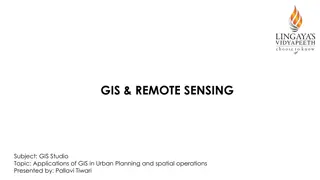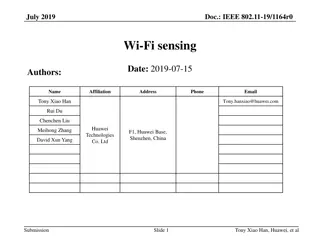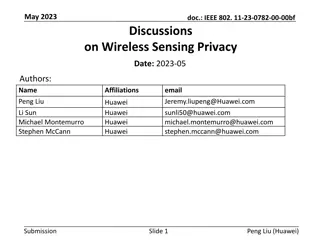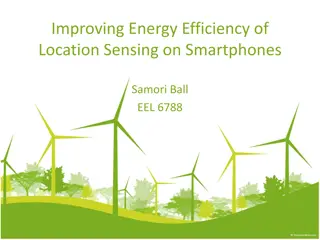Foundations of Image Sensing and Acquisition in GIS
Understanding the process of image acquisition is crucial for digital image processing in GIS. It involves using physical devices sensitive to different energy bands to convert images into digital form through digitizers. Various methods such as single sensors, sensor strips, and sensor arrays are used for image acquisition, and the use of filters can improve selectivity. Image sensors in digital cameras play a key role in converting optical images into electric signals, capturing pixels in photographs with high precision.
Download Presentation

Please find below an Image/Link to download the presentation.
The content on the website is provided AS IS for your information and personal use only. It may not be sold, licensed, or shared on other websites without obtaining consent from the author. Download presentation by click this link. If you encounter any issues during the download, it is possible that the publisher has removed the file from their server.
E N D
Presentation Transcript
Image Sensing and Acquisition Foundations for Applied GIS
Image Sensing and Acquisition Digital Image Digitizer Physical Device 2
Image Sensing and Acquisition Image acquisition is the first step in digital image processing. To acquire a digital image, two elements are required. The first is a physical device that is sensitive to a band in the electromagnetic energy spectrum, and that produces an electrical signal output proportional to the level of energy sensed. The second called digitizer is a device for converting electrical output of the physical sensing device into digital form. 3
Image Sensing and Acquisition Image acquisition using single sensor Image acquisition using sensor strips Image acquisition using sensor arrays 4
Image Sensors Single image sensor Line Sensor Array Sensor 5
Image Acquisition Using Single Sensor Image sensor used in digital cameras is a devise that converts an optical image to an electric signal. An image sensor is typically a charge couple devise or complementary metal oxide semiconductor(CMOS) sensor Both types can give very good results On the surface of these fingernail-size silicon chips are millions of photosensitive diodes ,called photosites, each of which captures a single pixel in the photograph to be. 6
Image Acquisition Using Single Sensor The use of a filter in front of a sensor improves selectivity. For example, a green (pass) filter in front of a light sensor favors light in the green band of the color spectrum. As a consequence, the sensor output will be stronger for green light than for other components in the visible spectrum. 7
Image Acquisition Using Single Sensor In order to generate a 2-D image using a single sensor, there have to be relative displacements in both the x- and y-directions between the sensor and the area to be imaged The single sensor is mounted on a lead screw, that provides motion in the perpendicular direction. Since mechanical motion can be controlled with high precision, this method is an inexpensive (but slow) way to obtain high-resolution images. 8
Image Acquisition Using Single Sensor Other similar mechanical arrangements use a flat bed, with the sensor moving in two linear directions. These types of mechanical digitizers sometimes are referred to as Micro densitometers. 9
Image Acquisition Using Sensor strips Arrangement of sensor elements in the form of a sensor strip. The strip provides imaging elements in one direction Motion perpendicular to the strip provides imaging in the other direction Sensing devices with 4000 or more in-line sensors is possible. 11
Image Acquisition Using Sensor strips Example: In-line sensors are used routinely in airborne imaging applications, in which the imaging system is mounted on an aircraft that flies at a constant altitude and speed over the geographical area to be imaged. Sensor strips mounted in a ring configuration are used in medical and industrial imaging to obtain cross-sectional images of 3-D objects The imaging strip gives one line of an image at a time, and the motion of the strip completes the other dimension of a two-dimensional image 12
Image Acquisition using sensor arrays Individual sensors arranged in the form of a 2 D array. This is the predominant arrangement found in digital cameras. A typical sensor for these cameras is a CCD array, which can be manufactured with a broad range of sensing properties and can be packaged in rugged arrays of 4000 X 4000 elements or more. The response of each sensor is proportional to the integral of the light energy projected onto the surface of the sensor. 14
Image Acquisition using sensor arrays The sensor array in is two dimensional, its key advantage is that a complete image can be obtained by focusing the energy pattern onto the surface of the array. Motion obviously is not necessary. 15

 undefined
undefined

























